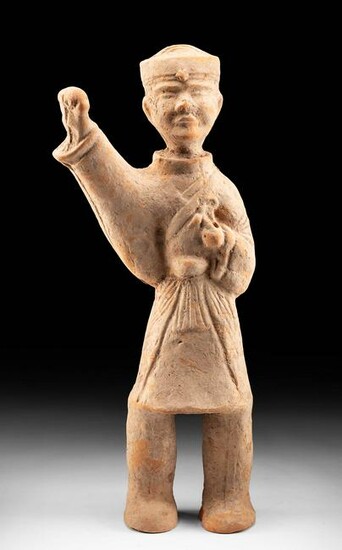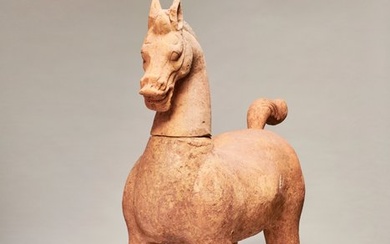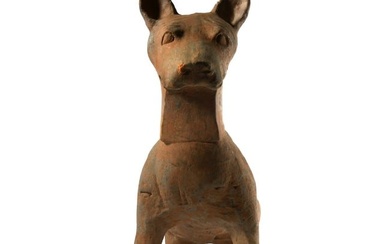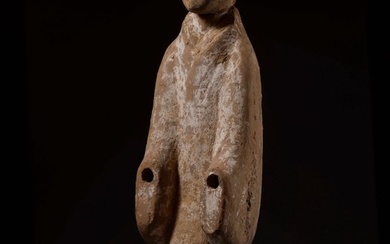Chinese Han Dynasty Terracotta Standing Male Figure
East Asia, China, Han Dynasty, ca. 206 BCE to 220 CE. A fabulous mold-formed pottery figure of a man, standing with his left hand held to his chest as he holds his right hand in a fist and extends it upwards and outwards, as though saluting or pledging. Topped by a hemispherical hat with a central star, the hollow figure is dressed in a knee-length robe tied with a belt over a pair of pants as a sash lays across his chest. His expressive visage features slender eyes under a straight brow, a bulbous nose, full lips in a slight frown, round cheeks, and a prominent chin. The ancient figure is accompanied by a large box with a cobalt blue fabric covering the exterior and a yellow silk interior lining. Size: 8.125" W x 23.125" H (20.6 cm x 58.7 cm)
The Han Dynasty was a period of wealth and stability for China, and the burial places of their rulers reflected this prosperity; inside of burial mounds, hundreds and sometimes thousands of figures were placed, recreating the daily life of the Emperor's court or a noble person's world. The creation of all these pottery figures spawned a huge industry and the remains of workshops have also been found near the burial mounds.
Han Dynasty elites had underground tombs full of pottery figures that were made to meet their every need in the afterlife. Tomb attendants like this one are part of a class of artifacts called mingqi - sometimes known as "spirit utensils" or "vessels for ghosts". They became popular in the Han Dynasty and would persist for several centuries. Alongside figures like this one were musicians, athletes, animals, structures? Even though they were mass produced, mingqi of the Han Dynasty often show a high level of detail and naturalism. These were designed to assist the po, the part of the soul of the deceased that remained underground with the body while the hun, the other part of the soul, ascended. Caring for the po seems to have taken on a new level of meaning in the Han period, with more elaborate rituals and tomb construction arising.
Provenance: ex-Phoenicia Holyland Antiquities, New York, New York, USA, acquired before 2010
All items legal to buy/sell under U.S. Statute covering cultural patrimony Code 2600, CHAPTER 14, and are guaranteed to be as described or your money back.
A Certificate of Authenticity will accompany all winning bids.
We ship worldwide to most countries and handle all shipping in-house for your convenience.
#162941
Condition Report: Expected surface wear as shown with nicks/chips, abrasions, and softening of detail commensurate with age. Otherwise, intact and excellent.
View it on
Estimate
Time, Location
Auction House
East Asia, China, Han Dynasty, ca. 206 BCE to 220 CE. A fabulous mold-formed pottery figure of a man, standing with his left hand held to his chest as he holds his right hand in a fist and extends it upwards and outwards, as though saluting or pledging. Topped by a hemispherical hat with a central star, the hollow figure is dressed in a knee-length robe tied with a belt over a pair of pants as a sash lays across his chest. His expressive visage features slender eyes under a straight brow, a bulbous nose, full lips in a slight frown, round cheeks, and a prominent chin. The ancient figure is accompanied by a large box with a cobalt blue fabric covering the exterior and a yellow silk interior lining. Size: 8.125" W x 23.125" H (20.6 cm x 58.7 cm)
The Han Dynasty was a period of wealth and stability for China, and the burial places of their rulers reflected this prosperity; inside of burial mounds, hundreds and sometimes thousands of figures were placed, recreating the daily life of the Emperor's court or a noble person's world. The creation of all these pottery figures spawned a huge industry and the remains of workshops have also been found near the burial mounds.
Han Dynasty elites had underground tombs full of pottery figures that were made to meet their every need in the afterlife. Tomb attendants like this one are part of a class of artifacts called mingqi - sometimes known as "spirit utensils" or "vessels for ghosts". They became popular in the Han Dynasty and would persist for several centuries. Alongside figures like this one were musicians, athletes, animals, structures? Even though they were mass produced, mingqi of the Han Dynasty often show a high level of detail and naturalism. These were designed to assist the po, the part of the soul of the deceased that remained underground with the body while the hun, the other part of the soul, ascended. Caring for the po seems to have taken on a new level of meaning in the Han period, with more elaborate rituals and tomb construction arising.
Provenance: ex-Phoenicia Holyland Antiquities, New York, New York, USA, acquired before 2010
All items legal to buy/sell under U.S. Statute covering cultural patrimony Code 2600, CHAPTER 14, and are guaranteed to be as described or your money back.
A Certificate of Authenticity will accompany all winning bids.
We ship worldwide to most countries and handle all shipping in-house for your convenience.
#162941
Condition Report: Expected surface wear as shown with nicks/chips, abrasions, and softening of detail commensurate with age. Otherwise, intact and excellent.







